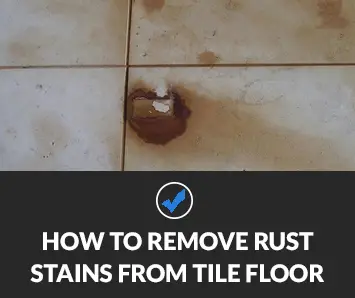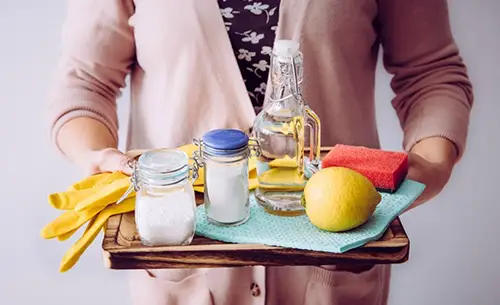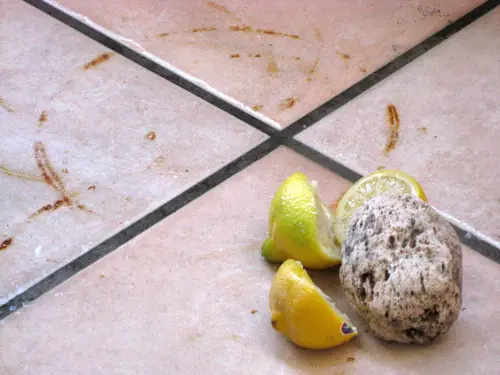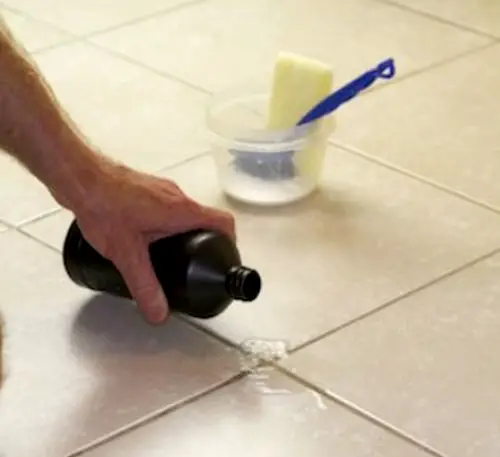Did you see our favorites?

To a greater extent than any other type of flooring, tile flooring elevates the beauty of our properties in every possible way. Cleaning them meticulously is critical, as several issues might occur, such as fading, rusting, or even cracking of flooring. Rust ing appears to be the most common problem that individuals have with their kitchens or any other damp places.
Rust stains can also be found on the floor due to metal furniture, home décor items, LPG cylinders, utensils, and other factors. Hard water is to blame for this, as rust deposits itself on your flooring giving it a dirty and chaotic appearance. Not only that, but the rust can cause tiles to weaken and cause holes. There’s no need to be concerned since you may solve this problem of rust stains and unsightly stains by applying some of your own goods in the following ways.

A rust stain is one of the most unsightly stains available. In the end, clean tiles give your house a fantastic appearance while also providing protection to those who live there.

When iron comes into touch with oxygen in a moist ambiance, it becomes rusted. Oxidation is the technical term for this process. Although most types of tiles are not composed of metal, they do contain some amount of iron. So, how does rust get to them in the first place?
Tiles, like many other surfaces, may be stained by a rusty item that is in contact with their surface.
For example, rusty towel cabinet legs might leave reddish-brown stains on your bathroom floor tiles. The same may occur if you have an obsolete metal soap dispenser on your tiled wall.

If you’ve been using the wrong chemicals to clean rust stains from your tiles, you may have been doing it wrong. It’s a myth that Coca-Cola can remove rust from any surface, for example. This method works best on rusted metal surfaces.
You may not like the flavor of lemon, but you’ll appreciate its cleaning abilities when it comes to rusted iron. Lemon juice may be used in a variety of ways as a cleaner. Pour it directly onto the afflicted area and leave it for five minutes; do not allow the juice to dry. After the five minutes are up, get an old toothbrush and rub away the mess. If you’re still having trouble removing the stain, add some more lemon juice to the affected region, along with salt, and rest it for three hours before scrubbing it away with a toothbrush using warm water.

Another way to remove rust stains from ceramic tiles is to combine lemon juice with baking soda and apply the resulting paste to the damage. This should be left in place for half an hour before being scrubbed off with a sponge or soft brush.
Salt and vinegar are fantastic for enhancing the flavor of your meals. They’re also beneficial for cleaning ceramic tiles rust away. Simply combine the two to make a paste, which is then applied to the discolored area and left in place for three to four hours. After you’ve washed off the solution, you should have clean tiles remaining.
Wear protective gloves for this technique of rust stain removal. When you’ve put the gloves on, combine borax with a tiny bit of lemon or lime juice. After that, apply the mixture using a spatula to the afflicted region. Allow it to dry completely before removing it with a sponge and warm water.
Vinegar is the most powerful cleaning agent available. Whether it’s a mineral deposit, grease, or rust, vinegar’s acidic nature allows it to dissolve any of these obstinate stains in no time.
Repeat the procedure one more time. The rust stain on the floor will gradually go away as you repeat the process.
Kerosene is the only solution for rusted materials. It’s comparable to vinegar, but it works faster and better.
Tomatoes are acidic in nature, just like lemons. It contains an acid that is perfect for removing deposited minerals or stains. If you don’t want to deal with cylinder marks in the kitchen any more, all you have to do is:

Cleaning your grout is a necessary task. While there are several cleaning solutions on the market that promise to make your grout clean and anything else, the price may be prohibitive. You’ll need a few simple household items that you’re most likely already using.
[product_card_static label=”” link=”https://www.amazon.com/dp/B000SKX0N6/?tag=shmulshmulcleaninglab-20″ image=”https://cleaningproductslab.com/wp-content/uploads/2021/10/B000SKX0N6.jpg” title=”CLR PRO Calcium, Lime and Rust Remover” details=”Quickly removes calcium, lime and hard water deposits, discoloration and dirt. Descales and cleans heat exchangers, radiators, tools, injection molds, plumbing and pipes.” btn_color=”#ffa226″ btn_name=”CHECK PRICE”]
Here are some techniques for cleaning your grout with oxide and baking soda.
The tiles may make or break your house. They come with a slew of advantages, including a long lifespan. Use these methods to get rid of rust stains and flaws quickly and painlessly. Make certain you use the appropriate cleaning solution for optimum results. Professional cleaners can assist you with this process as well.
[product_card_static label=”” link=”https://www.amazon.com/dp/B01HIN80ZI/?tag=shmulshmulcleaninglab-20″ image=”https://cleaningproductslab.com/wp-content/uploads/2021/10/B01HIN80ZI.jpg” title=”Lime-A-Way Lime Calcium Rust Cleaner” details=” Good for use on: Sinks & Fixtures, Tub & Tile, and Shower & Glass. Cleans the toughest hard water build-up so that surfaces stay cleaner for longer.” btn_color=”#ffa226″ btn_name=”CHECK PRICE”]
Lemon juice is only one of a variety of effective rust stain removers. Tomato juice, on the other hand, is quite acidic. If you don’t have any lemon juice, use tomato juice instead. Bleach, toothpaste, or white vinegar can all be used as cleaning solutions. It’s critical to include one of the mild abrasives in whatever cleaning solution you choose.
While rust stains on your beautiful tile floor might be alarming, you may rest confident that the stain can be removed safely. If you have worries about harm to the tile, try a small and inconspicuous patch with your preferred rust removal technique.
It’s critical to follow a regular cleaning schedule if you want your tiles to stay clean and free of rust stains. Unfortunately, if your tiles develop rust stains, you must remove them straight away. You can quickly eliminate the rust stains on your own using the techniques explained in this article.
Did you see our favorites?
CleaningProductsLab.com is a participant in the Amazon.com Services LLC Associates Program. As an Amazon Associate we earn from qualifying purchases.
Amazon and the Amazon logo are trademarks of Amazon.com, Inc. or its affiliates.
The information on this blog is not meant as a substitute for medical advice, and should not be taken as such.